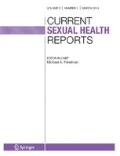Abstract
Sexual medicine physician education and patient care is needed. The establishment of departments of sexual medicine, certified fellowships, and approved residency programs would offer patient care, research, and education. The goal is to establish multidisciplinary departments of sexual medicine. Following the pattern used in sleep medicine, a new multidisciplinary department in sexual medicine would allow for improved diagnosis and treatment of sexual dysfunction and training of residents and fellows. There is a need for departments in the field of sexual medicine, and therefore, they are fiscally viable. However, there is a paucity of research funds. A department would need the support of the medical school or hospital administration. Medical education, basic science, and clinical research can provide improved and more accessible patient care. Departments of sexual medicine are needed to provide the physician education and patient care.
Similar content being viewed by others
References and Recommended Reading
World Association for Sexual Health: The Sexual Health for the Millennium Declaration. http://www.worldsexology.org/newsletter/01/nl01-06.asp. Accessed December 11, 2007.
American Board of Medical Specialties. http://www.abms.org/About_ABMS/member_boards.aspx. Accessed December 11, 2007.
Accreditation Council for Graduate Medical Education: Specialty Programs with Dependent and Independent Subspecialties. http://www.acgme.org/acWebsite/RRC_sharedDocs/sh_progs_depIndSubs.asp. Accessed December 11, 2007.
Goldstein I: That’s one small step for medicine, one giant leap for sexual medicine. J Sex Med 2007, 4:255–256.
Bloom DA: The origin of a species: pediatric urology. J Urol 2009, 170:1488–1492.
DeRogatis LR, Burnett AL: The epidemiology of sexual dysfunctions. J Sex Med 2007, [Epub ahead of print].
Parish SJ, Clayton AH: Sexual medicine education: review and commentary. J Sex Med 2007, 4:259–267.
McGarvey E, Peterson C, Pinkerton R, et al.: Medical students’ perceptions of sexual health issues prior to a curriculum enhancement. Int J Impot Res 2003, 15(Suppl 5):S58–S66.
Leeper H, Chang E, Cotter G, et al.: A student-designed and student-led sexual-history-taking module for second-year medical students. Teach Learn Med 2007, 19:293–301.
Kingsberg SA, Malemud CJ, Novak T, et al.: A comprehensive approach to enhancing sexual health education in the Case Western Reserve University School of Medicine. Int J Impot Res 2003, 15(Suppl 5):S51–S57.
Goldstein I: Addressing both genders in sexual medicine diagnosis and treatment. J Sex Med 2006, 3:949–951.
Athanasiadis L, Papaharitou S, Salpiggidis G, et al.: Educating physicians to treat erectile dysfunction patients: development and evaluation of a course on communication and management strategies. J Sex Med 2006, 3:47–55.
Rosen R, Kountz D, Post-Zwicker T, et al.: Sexual communication skills in residency training: the Robert Wood Johnson model. J Sex Med 2006, 3:37–46.
DeRogatis LR, Burnett AL: Key methodological issues in sexual medicine research. J Sex Med 2007, 4:527–537.
Pescatori ES, Giammusso B, Piubello G, et al.: Journey into the realm of requests for help presented to sexual medicine specialists: introducing male sexual distress. J Sex Med 2007, 4:762–770.
Dean J: Toward the establishment of a European qualification in sexual medicine: the ESSM Specialist Training Course, Oxford 2007. J Sex Med 2007, 4:1553–1558.
Science Blog: Three Harvard Medical School endowed chairs named simultaneously in sleep medicine. May 2004. http://www.scienceblog.com/community/older/2004/4/20043604.shtml. Accessed December 11, 2007.
Riley A: The birth and development of sexual medicine: reflections of my personal journey. J Sex Med 2007, 4:815–819.
Jackson G, Rosen RC, Kloner RA, Kostis JB: The second Princeton consensus on sexual dysfunction and cardiac risk: new guidelines for sexual medicine. J Sex Med 2006, 3: 28–36.
Huang V, Munarriz R, Goldstein I: Bicycle riding and erectile dysfunction: an increase in interest (and concern). J Sex Med 2005, 2:596–604.
Goldstein I, Lurie AL, Lubisich JP: Bicycle riding, perineal trauma, and erectile dysfunction: data and solutions. Curr Urol Rep 2007, 8:491–497.
Panzer C, Wise S, Fantini G, et al.: Impact of oral contraceptives on sex hormone-binding globulin and androgen levels: a retrospective study in women with sexual dysfunction. J Sex Med 2006, 3:104–113.
World Health Organization: The Right to Health Fact Sheet. http://www.who.int/hhr/Right_to_health-factsheet.pdf. Accessed December 11, 2007.
Author information
Authors and Affiliations
Corresponding author
Rights and permissions
About this article
Cite this article
Goldstein, S.W., Goldstein, I. Sexual medicine training: Is a department of sexual medicine feasible?. Curr sex health rep 5, 17–20 (2008). https://doi.org/10.1007/s11930-008-0004-y
Published:
Issue Date:
DOI: https://doi.org/10.1007/s11930-008-0004-y




